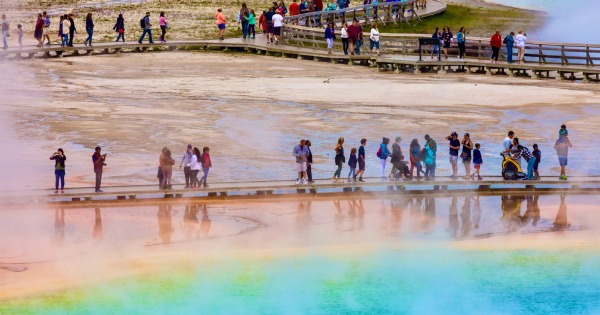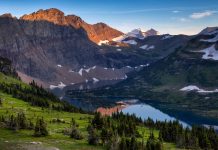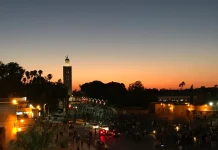In 1947, when my parents brought me to Yellowstone on my first visit, one difference then was that the regional population was small and the phenomenon of people owning trophy homes and vacation getaways, compared to today, did not exist. Recreation use was low tech involving relatively few people.
Today many of the visits being notched in Yellowstone and Grand Teton National Parks are coming from locals in neighboring towns and cities, including the Salt Lake City metro area, meaning that on top of global tourism bringing record-setting numbers of plane passengers to the Bozeman, Idaho Falls, and Jackson Hole airports, we now also have many more people living near the doorstep of the national parks.
It is why the crowds, even if higher travel costs should slow some vacationers from coming here, are not going away. And it’s why our elected leaders, public land managers, planners and analysts urgently need to consider this fact as they ponder the future.
Today many of the visits being notched in Yellowstone and Grand Teton National Parks are coming from locals in neighboring towns and cities, including the Salt Lake City metro area, meaning that on top of global tourism bringing record-setting numbers of plane passengers to the Bozeman, Idaho Falls, and Jackson Hole airports, we now also have many more people living near the doorstep of the national parks. It is why the crowds, even if higher travel costs should slow some vacationers from coming here, are not going away.To return to the question of what does it all mean for the Greater Yellowstone region’s public lands? Unfortunately, what comes to mind is a continuation of the crowds that materialized during the Covid pandemic, along with more garbage and sewage issues, miles-long traffic jams, noise, air pollution, over-flowing parking lots, overwhelmed services, and countless on-line and social media postings with geotagged selfies.
The past couple of season’s onslaught can be characterized in many different ways. At least 1800 rolls of toilet paper/day were required for Yellowstone’s public toilets alone. (Who knows what was happening with human waste on adjacent Forest Service lands related to dispersed recreation and inadequate facilities to handle overflow at semi-developed sites).
Not to mention, in Yellowstone, 5000 notices of resource and other violations were issued and 1500 motor vehicle accidents occurred in 2019-2020. The root cause of this kind of crushing tourism is not attributable to the agencies themselves.
While tourism promotion entities are partially responsible, still others approach our region as if the end goal is to strive for increased capacity targets and an ever-expanding infrastructure to deal with the rising visitor tide in a never-ending cycle of growth. Something that has not been discussed much in the media is the fact record visitation numbers during the Covid years were achieved without the huge volumes of bus tourism, that is, without international travelers.
The distinguished author and wildlands advocate Wallace Stegner famously wrote that our national parks “reflect us at our best.” It was an observation made in a different time when total visits to Yellowstone were less than half of what they are today, and when Greater Yellowstone had half of its current population of permanent and season residents. What is not out of date is what the cartoon character Pogo said, “We have met the enemy and he is us.”
Front-country areas are often no longer the picture of pristine, natural, or America the beautiful most of us imagine or may have enjoyed in the past. I’m not the first to point out that true sustainability of the character of our region is in question; somewhere and somehow there should be some limits. In a society that frequently preaches freedom and liberty and alternative facts over common sense, this is easier said than done.
While the total Greater Yellowstone Ecosystem area is around 23 million acres, the two national parks combined comprise only 2.5-million acres of it; the five national forests (originally nine forests consolidated into five) make up another 15-million acres of the public land involved.
We often tend to focus on the parks, but the national forests and other Greater Yellowstone public lands are likewise also experiencing record use and even its employees lament that some parts of the backcountry are being turned into front country.
A case study is this: Forest Service regulations pretty much allow camping anywhere unless otherwise restricted. The activity is called “dispersed recreation,” meaning all parts of a national forest are open to camping unless specified otherwise. It may be a beloved tradition but again borne in a different time when freedom and liberty was being expressed in smaller numbers of campers on public lands.
Imagine if Forest Service-style dispersed recreation were allowed and promoted in Yellowstone and Grand Teton National Parks? The reasons why it is not a sound idea when it comes to protection is obvious. With the large crowds descending on national forests today, it should invite an agency review to reform practices and policy.
Imagine if Forest Service-style dispersed recreation were allowed and promoted in Yellowstone and Grand Teton National Parks? The reasons why it is not a sound idea when it comes to protection is obvious. With the large crowds descending on national forests today, it should invite an agency review to reform practices and policy.
With campsites in developed facilities in Yellowstone booked many months in advance and with motel rooms difficult to come by during an expanded peak season, it sends many seeking ready alternatives to the national forests.
Dispersed camping on national forests and BLM lands is colloquially called “boondocking.” It means, with some exceptions, not having to pay versus fees required for using traditional developed campgrounds that have hardened sites, constructed tent pads, tables, toilets, potable water, and fireplaces.
Boondocking can entail RVs, trailers, and tents setting up at pull offs, parking areas, trailheads, meadows, streamside terraces, and open ridgetops—pretty much anywhere one can get off road. It is our urban population’s version and popularization of camping—called the “camping crunch.”
The national forests have a five-day (some have a 14 to 16-day) stay limit, which is often violated or not enforced. Boondockers, like in a game of musical chairs, merely shift around to different sites (if you can find a vacant spot) before time limits are exceeded.
Garbage, trash, litter, human waste, and impacts on water quality, vegetation, erosion, wildlife habitat, multiple fire rings and fire hazard, are not uncommon. Dispersed sites near gateway communities can frequently end up serving as makeshift bedroom places for seasonal workers, contractors, and low-budget accommodation needs in light of the lack of affordable housing and the trend of long-term rentals being converted to short-term vacation properties.
Yes, the very people who keep our tourism economy running can’t find rentals, or can’t afford them, and yet the promotors of our nature-based economy tout how much prosperity is being created.
Not too many years ago, on road trips, one could discover suitable dispersed sites and have it all to yourself. Throw a sleeping bag down in the sagebrush or meadow. No more. Boondocking sites, their locations and descriptions are frequently shared by users on the Internet and social media, commonly geotagged and heavily used. The rules, information, and location maps for designated sites are also commonly posted or handed out by the agencies and tourist bureaus.
For perspective on the extent of the activity, in efforts to get a handle on dispersed camping management on just two National Forest Ranger Districts on the Bridger-Teton National Forest alone, 428 dispersed sites were inventoried.
Admittedly, the sites are in proximity to Grand Teton National Park and Jackson Hole, but if some approximate percentages of those numbers are extrapolated to occur on other national forests across the Greater Yellowstone close to higher-growth towns and resort communities, it amounts to an astounding sum of campsites and campers. Keep in mind, they are in addition to existing traditional developed campgrounds and private land KOA.
As mentioned, dispersed camping is not allowed in national parks and is not to be confused with developed recreation sites mentioned above, which are generally first come/first served, require a fee, provide facilities, and have short-term stay requirement. For example, there are 12 such managed campgrounds with 2150 camp sites in Yellowstone Park alone. The park also has 293 by permit-only backcountry campsites limited to between 1- and 3-day stays. And, similarly, in Grand Teton Park, there are six developed campgrounds and one RV park totaling 1050 campsites; there are also 300 by reservation-only, limited-stay backcountry campsites.
The massive and increasing visitation numbers in the Greater Yellowstone and Yellowstone Park have been attributed to a number of converging forces, such as social trends, social media, advertising, foreign travel, Covid-19, and a burgeoning US population. In total it represents recreation on a mind-boggling industrial-scale level.
One datapoint indicates that Yellowstone’s tourism activity alone contributes $642 million in annual economic benefits to the immediate region. It raises the old question: who or what pays the costs and who receives the benefits? What’s not being factored into the accounting ledgers are the downsides and lacking is what the amorphous term “sustainable” means.
[Note: It’s jaw-dropping to think that this time-lapse video of tourists moving through Yellowstone’s Hayden Valley in summer, with bison and bear jams, sometimes bringing gridlock, was from a couple of summers before Covid resulted in a huge increase in visitation. Video courtesy National Park Service. Is it possible to separate people from their cars and, in the absence of limits, is this how the “Yellowstone experience” will be defined? Is this what visiting the cradle of American wildlife conservation is supposed to look like?]










